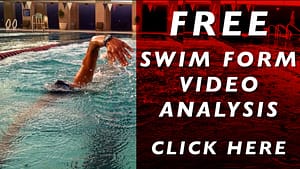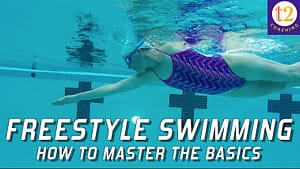It’s no secret that swimming is a technique-intensive sport. Whether your goal is to develop a healthy, injury-free fitness routine or perform faster in races, good form is a fundamental prerequisite.
Giving advice without demonstrating in person is more difficult. Seeking out a local coach with experience teaching adults is best, one that uses above and underwater video so the swimmer can see that they are doing right and wrong is mutually beneficial.
 Send an email to wendy@t2coaching.com and I will send you guidelines on how to send me a video so I can evaluate your form. Watching videos is useful cause you can pause and focus on the phases of the free style stroke while watching the video. View me swimming here
Send an email to wendy@t2coaching.com and I will send you guidelines on how to send me a video so I can evaluate your form. Watching videos is useful cause you can pause and focus on the phases of the free style stroke while watching the video. View me swimming here
If you are looking a step-by-step approach on how to develop a program to fix common faults, check out my 5 step-by-step system I follow when instructing.
Breathing
The first step is evaluating how to breath. A swimmer must be comfortable breathing before they can focus on body balance, which is needed before they learn swim mechanics. If they work on mechanics before they are breathing efficiently, they will be frustrated. If they can breathe, we move on to step 2 (balance and kick).Even is the swimmer is comfortable breathing, I still go over the 4 things that cause breathlessness in cause during the course of their training they encounter breathing issues. The 4 things that cause breathlessness are not exhaling immediately before they inhale, lower body dragging, kicking too much and dropping their extended arm while turning to inhale.
If someone is having breathing issues typically they cannot swim more then 1-1.5 lengths before they are breathless. I have them use a kickboard and practice inhaling with their face above water and exhaling underwater. The key to breathing is a forceful exhale before inhale. Then they will kick on their side while exhaling under water and inhaling about water.
2. Kick
I am not much of a kicker. I propel myself thought the water with my lats, back. Proper kick for triathletes stems from the hip. Engaging quads and hip flexors, relaxing the lower leg beyond the kick. Flexible ankles help. As mentioned about kicking to much to propel yourself with fatigue you sooner cause you are using large muscle groups and that will increate your heart and breathing rate and cause fatigue sooner.
If someone cannot kick (they either show no forward progression or move backwards) we discuss kicking (pushing) from the quad and hip flexor. Once we’ve address any breathing and kicking issues, I evaluate body balance and rotation. If they are dragging their legs on the bottom, if they are not rotating from left hip to right hip, on a few stroke drills to help correct that.
3. Body Balance Rotation
When you swim you are either on your right or left hip. When you rotate from hip to hip, your shoulder is in line with your hip. Some swimmers are taught shoulder rotation, I teach hip rotation, your shoulder follows. If you are a one side dominate breather you are typically always on one hip. For example a right side dominate breather tends to be on their left hip and not knowing that they should complete the rotation cycle on their right hop too, even if they don’t breath to the left, it is still important. Bi-lateral breathing helps with hip rotation. Knowing you should rotate on your hip to breath, helps with getting comfortable breathing to the non dominate side
A common problem with most newbie swimmers is poor body position, which can lead to legs sinking. This brings their legs closer to the surface of the water and produces a “downhill” swimming sensation. Also hand entry will help with body weight distribution
Another common theme among newbie swimmers is not rotating on the hip or side they don’t breathe on. Most often, they are right-side-dominant breathers. They consistently rotate on one side to breathe and never fully rotate on the non-dominant side. I discuss the benefits of bilateral breathing, breathing on both left and right hips, and the value that provides with proper body balance and rotation. Basically, when your left fingertips enter the water, rotate on your left hip, when your right fingertips enter the water, rotate on your right hip, whether you are breathing on that stroke or not.
Once breathing, body balance and rotation are fine-tuned, I focus on the mechanics of freestyle. There are three main phases of the stroke: recovery, hand entry, and underwater catch/pull. I often see swimmers recovering with straight arms and entering the water with their palm and elbow at the same time. creating a straight-armed pull with no high-elbow catch. In the end high-elbow recovery sets them up for a nice fingertip-angled entry when they rotate which, in turn, sets up a high-elbow catch and pull.
 4. Phase 1 Recovery
4. Phase 1 Recovery
What your arm is doing out of water. Many newbies have straight arms and extend the greatest amount in front of them before entry.
High-elbow recovery means leading with your elbow and relaxing the phase of your stroke where your arm exits the water. I frequently remind swimmers to swim with their fingertips below their wrist and below their elbow, and to drag their fingertips along the surface of the water on the recovery.Here are two keys drills I use to create a high-elbow recovery:
Thumbslide: https://www.youtube.com/watch?v=b3ID1VtdLG0
Fingertip drag: https://youtu.be/DAxucJPeaUg
5. Phase 2 Hand Entry
I believe how the swimmer hand enters the water is the most important phase to set the swimmer up for a strong “catch” and “push”, the pull phase of the stroke
Most swimmers that learn to swim at an adult are taught to reach as far as they can either before or after entry. This can put alot of stresss on the athlete shoulder and often creates igniting the pull with a dropped elbow. Entry phase means an angled, deep hand entry, which can help create a high elbow catch and pull phase.
Fist drill:
https://www.youtube.com/watch?v=mi-4bsv6Psk, https://www.youtube.com/watch?v=b2uUSEkX3v0
Head-out-of-the-water drill is just as the name implies. Swim with your head out of the water, increase your arm recovery rate, and focus on an angled hand entry making sure not to reach and flatten your hand at entry.
https://www.youtube.com/watch?v=Mv4E3ocazF0
Attention to body balance, rotation, high elbow recovery and hand entry will set you up to develop a stronger pull and power phase of the stroke. I will discuss that phase next time. If you make stroke drills an integral part of your training, you will be rewarded with fewer injuries and faster times.
6. Phase 3 Catch and pull
Now that you are comfortable with breathing, body balance, rotation, high elbow recovery and hand entry, your underwater pull should be set up to put some power below. When working on your pull, hold your breath, look down and watch your hands pull thought the water over the black lane line. Your arms should not be wider then hips and not crossing the center line. Then the “catch” proceeds the pull and the right place and all your strength and power should be put into the push, past your hips, scrapping your thigh with every arm pull.
What to Master the Basics of Swimming? Click here to learn more
